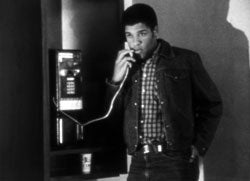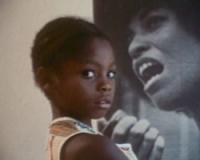Robert Wheaton’s short A Little Off Mark (1986) tells the story of a young student (Peter Parros) trying to develop his self-confidence and find a girlfriend. Especially in the context of the "L.A. Rebellion" program as a whole, this film is interesting for its sweet and simple nature. A Little Off Mark is populated almost exclusively by African American characters and their personal lives, yet the film’s narrative is not actually backgrounded by a racist society. Far from being short-sighted, this can be a liberating idea: instead of being beholden to focus on African Americans as an oppressed group and leaving all other possible narrative possibilities to “white” films, this film explores this basic human concern of teenage anxiety with a Black cast. Mark is Black, but he is also a student, a young adult and a nervous newcomer to the world of dating who is experiencing feelings recognizable to many viewers.

Mark’s best friend in this film is played by a young Lee Daniels, producer/director of Precious (2009) and the first Black director to have a film nominated for a Best Picture Oscar. After graduating from UCLA, Wheaton later worked on several feature films including Mario van Peebles’ Panther (1995) and Forest Whitaker’s Waiting to Exhale (1995). He is involved with several African American arts/culture organizations such as the Watts Cinema and Education Center and the Watts Summer Festival.
Charles Burnett’s film My Brother’s Wedding is also concerned with problems that are more widespread in nature and not necessarily unique to African Americans in Los Angeles (especially compared to the film he is most known for, Killer of Sheep). While Burnett still transmits a stunning depiction of the South Central neighborhood where he grew up, the plot is motivated more by common family issues than with race and class struggles. Pierce Mundy (Everett Silas) works for his parents' laundry while his successful and ambitious brother Wendell (Dennis Kemper) is preparing for his marriage into a well-off family. However, Pierce mainly focuses himself with youthful and less credible activities: hanging out with his best friend Soldier (Ronnie Bell) and trying to get dates with the girls around the neighborhood.
Comparing Killer of Sheep and My Brother’s Wedding is interesting and productive. While Killer of Sheep, shot in black and white, has had the most acclaim for Burnett, My Brother’s Wedding is an enjoyable showcase of his skill with color film and his many talents in composition and aesthetics. While My Brother’s Wedding may touch on issues of upward mobility within a single family, the film also makes us laugh and gives a detailed portrait of the day in the life of a young man, with less attention given to the structures that may govern his future. Ultimately it is this portrait that is invaluable to both our history and our culture. —Paul Wuest






 Mobile Navigation
Mobile Navigation


Comments